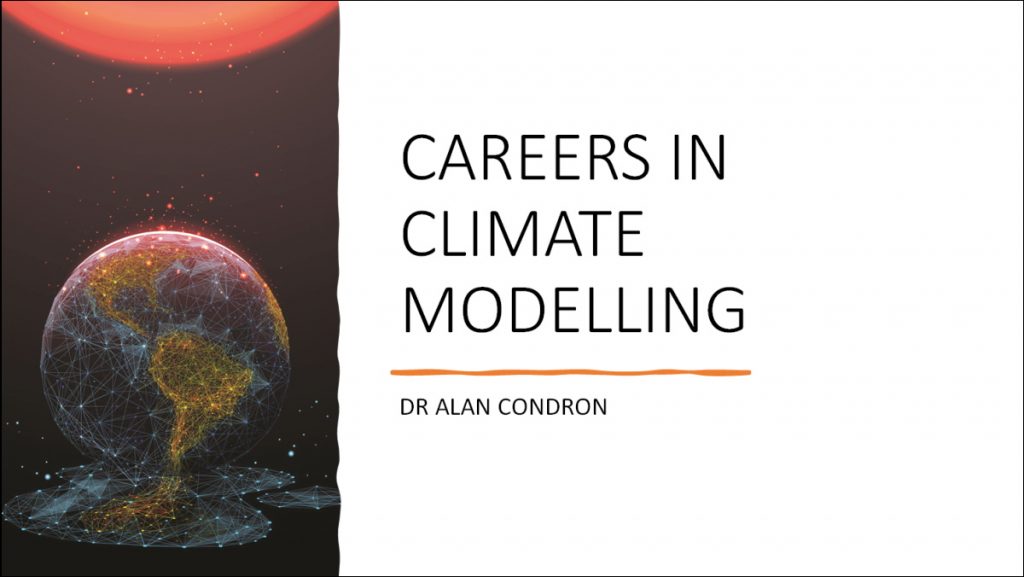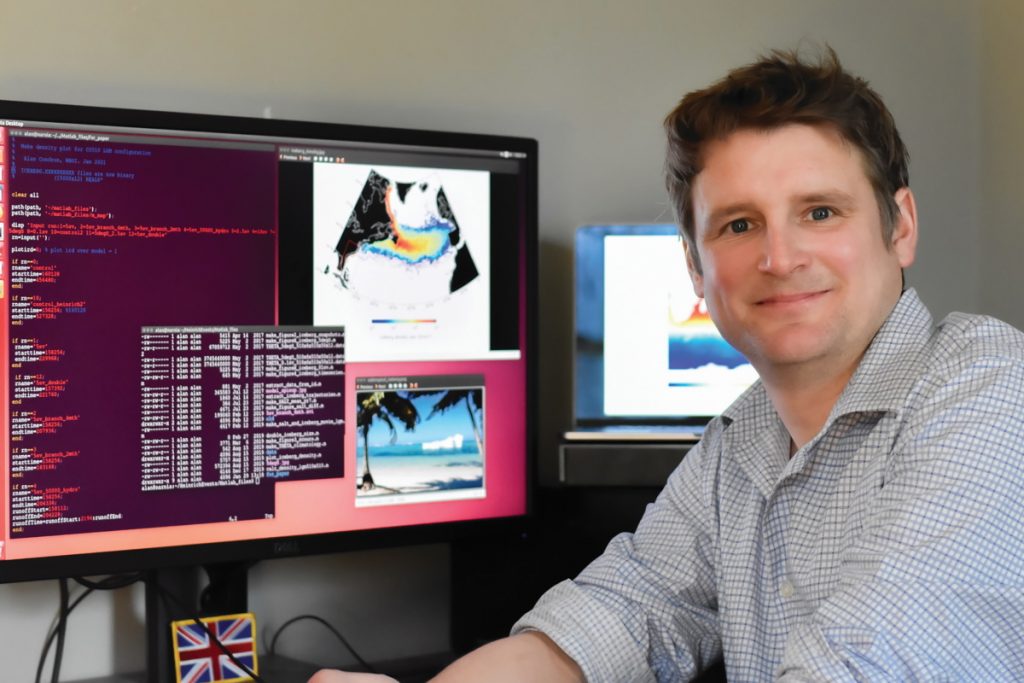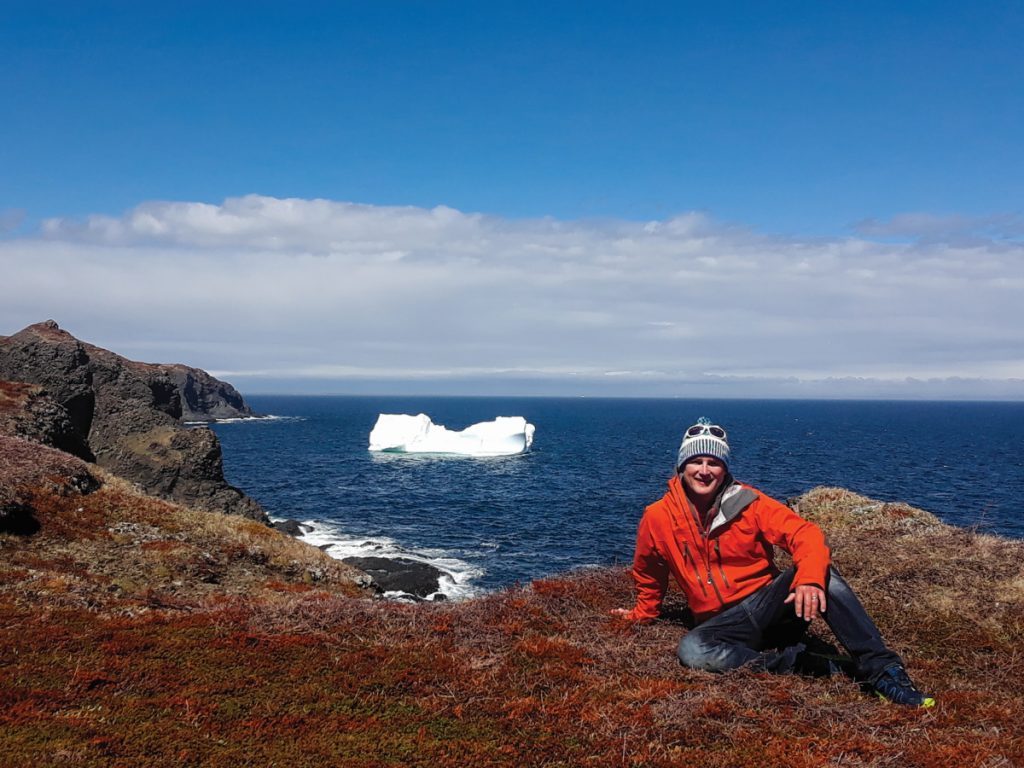Climate modelling: predicting the future of the planet
The Earth’s climate is changing due to greenhouse gas emissions resulting from human activity. Being able to predict these changes is crucial for preparing for their effects and for providing the motivation needed to reduce emissions. Dr Alan Condron of the Woods Hole Oceanographic Institution is developing some key climate models to bring these predictions into existence
TALK LIKE A CLIMATE MODELLER
CLIMATE CHANGE – a change in regional or global climate patterns, generally caused by changes in the planet’s atmospheric or ocean circulation. Many of the changes we predict will occur in the future are a result of increased greenhouse gases caused by humans burning fossils
ICE CORE – a cylinder of ice obtained by drilling down into an ice sheet or glacier. The layers of ice towards the bottom of the cylinder are older than those at the top and so their characteristics provide a record of the climate in the past
LATITUDE – the distance of a place from the equator, with 0° beginning at the equator and 90°the north or south pole
NUMERICAL MODEL – a type of mathematical simulation capable of performing complex predictions
OCEAN CIRCULATION – the movement of water in the ocean basins and a key regulator of climate
PALAEOCLIMATOLOGY – the study of the Earth’s past climate, used to understand modern climate change
PARIS AGREEMENT – a landmark international treaty, effective from 2016, that sets out a global framework for avoiding dangerous climate change
RUNOFF – the draining of water from land into a larger water body (e.g. the ocean)
“The ultimate goal of my research is to determine what causes the Earth’s climate to change abruptly,” says climate modeller Dr Alan Condron. “To do this, I use numerical models to determine what factors drove changes in climate, tens to hundreds of thousands of years ago.” Extreme and rapid climatic changes have happened in the past, with profound impacts for life on Earth, and it is very possible these could happen again – and are potentially already happening. “Dramatic shifts in global temperatures or rainfall patterns would directly affect human society,” says Alan.
The Earth’s climate is a dazzlingly complex system and predicting how it will change is no easy task. There is a huge array of factors to consider: not only greenhouse gas emissions, but many other variables such as deforestation, ocean chemistry and melting ice, to name a few. Alan is currently focusing on one particular factor. “A key part of my research focuses on determining whether changes in freshwater runoff from melting ice sheets near the Earth’s poles could trigger abrupt shifts in climate,” he says.
FROM ONE POLE…
At present, Europe benefits from the Gulf Stream, a flow of warm water from the tropics of the Americas, across the North Atlantic and to the shores of western Europe. The current warms the air above it, which is why parts of Europe are generally much warmer than places of the same latitude in Canada. However, the Gulf Stream (and consequently Europe’s mild climate) would rapidly change if this supply of heat was to suddenly shut down.
“The Arctic is basically a vast reservoir of relatively fresh ocean water, covered by entirely fresh floating sea ice,” explains Alan. “Changes in the atmosphere can cause this stored freshwater and sea ice to be released into the North Atlantic and disrupt existing ocean currents.” A lot of this frozen freshwater is also stored on land, especially within Greenland’s massive ice sheet. When this ice melts, it not only affects ocean currents but also contributes to sea level rise.
As the Gulf Stream flows towards Europe, the warm waters within it gradually cool and sink, ultimately returning south as cold and deep waters, before rising again in the warmer tropics and continuing the cycle. However, the introduction of freshwater from the Arctic would make surface waters less dense and, therefore, more difficult for them to sink. This would slow the entire cycle, meaning less heat would get transported to Europe, and so Europe would experience a much colder climate. “Much of my research is spent investigating whether such a scenario will occur in the future,” says Alan.
…TO ANOTHER
Alan’s research also investigates the other end of the Earth: the Antarctic. “This is a new avenue for my group, but it is turning out to be extremely fascinating and exciting,” he says. Antarctica releases five times more freshwater into the ocean than the Greenland ice sheet, so is of great significance.
The west Antarctic ice sheet also has the potential to undergo a rapid runaway ice collapse, that once begun could become unstoppable, even if greenhouse gas emissions were cut to zero. “As the ice sheet starts to collapse it releases enormous volumes of cold freshwater into the ocean which, since this water is much less dense than the salty oceanic waters, would remain on the ocean’s surface where it could allow a thick layer of floating sea ice to grow,” Alan explains. “The white ice would reflect the sun’s warmth, rather than absorbing it as sea water does, which could cause a worldwide cooling effect.”
Reference
https://doi.org/10.33424/FUTURUM117
© Julie Condron Photography
Looking for icebergs in Newfoundland, Canada
Alan poses in front of an iceberg in Newfoundland.
CLIMATE CHANGE – a change in regional or global climate patterns, generally caused by changes in the planet’s atmospheric or ocean circulation. Many of the changes we predict will occur in the future are a result of increased greenhouse gases caused by humans burning fossils
ICE CORE – a cylinder of ice obtained by drilling down into an ice sheet or glacier. The layers of ice towards the bottom of the cylinder are older than those at the top and so their characteristics provide a record of the climate in the past
LATITUDE – the distance of a place from the equator, with 0° beginning at the equator and 90°the north or south pole
NUMERICAL MODEL – a type of mathematical simulation capable of performing complex predictions
OCEAN CIRCULATION – the movement of water in the ocean basins and a key regulator of climate
PALAEOCLIMATOLOGY – the study of the Earth’s past climate, used to understand modern climate change
PARIS AGREEMENT – a landmark international treaty, effective from 2016, that sets out a global framework for avoiding dangerous climate change
RUNOFF – the draining of water from land into a larger water body (e.g. the ocean)
“The ultimate goal of my research is to determine what causes the Earth’s climate to change abruptly,” says climate modeller Dr Alan Condron. “To do this, I use numerical models to determine what factors drove changes in climate, tens to hundreds of thousands of years ago.” Extreme and rapid climatic changes have happened in the past, with profound impacts for life on Earth, and it is very possible these could happen again – and are potentially already happening. “Dramatic shifts in global temperatures or rainfall patterns would directly affect human society,” says Alan.
The Earth’s climate is a dazzlingly complex system and predicting how it will change is no easy task. There is a huge array of factors to consider: not only greenhouse gas emissions, but many other variables such as deforestation, ocean chemistry and melting ice, to name a few. Alan is currently focusing on one particular factor. “A key part of my research focuses on determining whether changes in freshwater runoff from melting ice sheets near the Earth’s poles could trigger abrupt shifts in climate,” he says.
FROM ONE POLE…
At present, Europe benefits from the Gulf Stream, a flow of warm water from the tropics of the Americas, across the North Atlantic and to the shores of western Europe. The current warms the air above it, which is why parts of Europe are generally much warmer than places of the same latitude in Canada. However, the Gulf Stream (and consequently Europe’s mild climate) would rapidly change if this supply of heat was to suddenly shut down.
“The Arctic is basically a vast reservoir of relatively fresh ocean water, covered by entirely fresh floating sea ice,” explains Alan. “Changes in the atmosphere can cause this stored freshwater and sea ice to be released into the North Atlantic and disrupt existing ocean currents.” A lot of this frozen freshwater is also stored on land, especially within Greenland’s massive ice sheet. When this ice melts, it not only affects ocean currents but also contributes to sea level rise.
As the Gulf Stream flows towards Europe, the warm waters within it gradually cool and sink, ultimately returning south as cold and deep waters, before rising again in the warmer tropics and continuing the cycle. However, the introduction of freshwater from the Arctic would make surface waters less dense and, therefore, more difficult for them to sink. This would slow the entire cycle, meaning less heat would get transported to Europe, and so Europe would experience a much colder climate. “Much of my research is spent investigating whether such a scenario will occur in the future,” says Alan.
…TO ANOTHER
Alan’s research also investigates the other end of the Earth: the Antarctic. “This is a new avenue for my group, but it is turning out to be extremely fascinating and exciting,” he says. Antarctica releases five times more freshwater into the ocean than the Greenland ice sheet, so is of great significance.
The west Antarctic ice sheet also has the potential to undergo a rapid runaway ice collapse, that once begun could become unstoppable, even if greenhouse gas emissions were cut to zero. “As the ice sheet starts to collapse it releases enormous volumes of cold freshwater into the ocean which, since this water is much less dense than the salty oceanic waters, would remain on the ocean’s surface where it could allow a thick layer of floating sea ice to grow,” Alan explains. “The white ice would reflect the sun’s warmth, rather than absorbing it as sea water does, which could cause a worldwide cooling effect.”
Some may think this sounds like good news, considering greenhouse gases are otherwise heating up the atmosphere, but Alan offers a word of caution. “This should not be regarded as a ‘global cooling’ scenario, or a solution to combat global warming” he says. “According to our model, even with this cooling effect, average global temperatures would still be 3ºC warmer than today.”
KNOWLEDGE GAPS
“My research has highlighted many uncertainties in how ocean circulation and climate respond to freshwater input from ice sheets,” says Alan. “For instance, I have found that our climate system is especially sensitive to freshwater coming from high latitudes.” Alan’s explorations of historical climate change have also thrown up some perplexing results. “Since the last major ice age, there have been times when huge volumes of freshwater entered the ocean,” he says. “However, rather than seeing a weakening in ocean circulation and climate cooling, we see the opposite response. It is important to unravel this mystery to understand the effects of human activities on the global climate.”
TIPPING POINTS
Forty years ago, it was thought that historical changes to Earth’s climate had been a gradual process, largely driven by variations in the Earth’s orbit around the Sun. This idea changed in the 1980s, when researchers investigating ice cores found there had been many periods in the past when the North Atlantic climate had warmed dramatically in just a few decades. “These dramatic changes are now known as Dansgaard-Oescher events and are considered classic examples of how rapidly Earth’s climate can change,” says Alan. “They are very relevant to my research because they are thought to have been caused by changes to the circulation of the North Atlantic Ocean.”
Dansgaard-Oescher events are a major example of a tipping point: when climate change leads to a runaway effect that cannot be stopped, but instead gathers momentum as changes become more and more drastic. It is thought that the North Atlantic system could act as a major tipping point, as could Antarctic melting on a longer timescale. Predicting when these might occur, and doing everything we can to prevent them, is a major priority.
“It seems we have reached a point where human activities are playing the dominant role in steering climate change, compared to other factors,” says Alan. “This is very different from past climatic changes. Historically, freshwater runoff has been a main driver of abrupt climate change, but this time its role is quite uncertain. Clearing up this uncertainty is what my research hopes to achieve.”
 DR ALAN CONDRON
DR ALAN CONDRON
Assistant Scientist, Woods Hole Oceanographic Institution, USA
FIELD OF RESEARCH: Climate Change
RESEARCH PROJECT: Investigating past incidences of climate change to model future changes to the climate, especially with regards to the introduction of freshwater from high latitudes into the ocean.
FUNDERS: National Science Foundation, US Department of Energy
© Julie Condron Photography
ABOUT CLIMATE MODELLING
Alan’s work has a significant role to play in anticipating, and responding to, possible future scenarios for the world’s climate. He explains how he makes these predictions and why they are important for society.
WHAT ARE CLIMATE MODELS?
A climate model can be as simple as a one-line equation that calculates average temperature on Earth by incorporating estimates of how much energy from the Sun is absorbed or reflected into space. However, more precise models are far more complex, going so far as three-dimensional ‘Earth systems’ that comprise countless lines of computer code and incorporate many different climatic processes. The level of complexity needed depends on what questions need to be answered.
HOW LONG DOES IT TAKE TO CREATE A CLIMATE MODEL?
It depends on its complexity. Simple models can be created in a few hours, but complex models can take several years. These models are so complex and contain so many different components of the climate system, that they are usually developed at dedicated modelling centres by a full team of programmers and climatologists.
WHAT ARE THE BENEFITS OF CLIMATE MODELS?
Climate models are the only way we can predict future climate change. For instance, they are used by the UN and governments around the world to calculate how much we need to reduce greenhouse gas emissions to achieve the Paris Agreement’s goal of limiting temperature rise to 2ºC.
WHAT ARE THE LIMITATIONS OF CLIMATE MODELS?
All models are simplifications of the real world. In the real climate system, there are many processes that are either too complex or not understood well enough to fully simulate. If the model does not accurately describe a component of the climate system, predictions may deviate from what the real outcome would be. Right now, we are working to make models as accurate and close to reality as possible.
WHO USES CLIMATE MODELS?
Historically, climate modelling was the realm of just a few specialists. These days, they are run by glaciologists, geologists, palaeoclimatologists and biologists – to name just a few. With the advent of the internet and easily accessible high-powered computers, anyone with a laptop can download and run many useful and informative climate models.
• There are many pathways towards climate modelling, but Alan recommends getting a degree in mathematics, physics or computer science, “although an interest in computer programming and Earth Science’s (geography, geology) would also get you a long way. There is no magic formula!”
• According to QS World University Rankings, the best universities for mathematics or physics are MIT, Harvard, Stanford, Cambridge and Oxford. Alan says, “There are also many other great universities out there, where you can get the same education but that don’t require you to have ‘top grades’. In fact, if you’ve got commitment all you need is to join a local library and read books on these subjects.”
• A number of institutes specialise in climate modelling and often offer internships for students or postgraduate positions. In the UK, Alan suggests looking into research institutes such as ECMWF at Reading University, the Met Office and National Oceanography Centre, Southampton. In the US, he recommends the Los Alamos National Lab, National Center for Atmospheric Research (NCAR), Princeton and MIT. If you are also interested in studying ‘past climate change’, the universities of Leeds, Bristol and Sheffield (UK) and the University of Massachusetts Amherst, Brown University and Columbia/Lamont (USA) are great places to look.
• According to Glassdoor, the average salary for a climate scientist in the US is around $77k.
Alan recommends getting a solid background in mathematics, physics, and/ or computer sciences at school. He adds that his Earth science degree was invaluable in opening his eyes to the applications of numerical modelling. “If you pursue your work to the master’s and/or PhD level then I’d also encourage you to explore a range of research options. When I began my career, I was working in a lab processing soil samples. Turns out I was pretty rubbish at it and much better at computer modelling!”
ALAN’S TOP TIPS
01 If you’re considering climate modelling, make sure you enjoy coding! Start by learning to write code for something you’re interested in – maybe a simple computer game you can test on your friends. And there are lots of programming languages that are free to use.
02 There are many pathways to become a climate modeller – from backgrounds in computer science, physics or Earth sciences, to name a few.
HOW DID ALAN BECOME A CLIMATE MODELLER?
WHAT DID YOU WANT TO BE WHEN YOU WERE YOUNGER?
I had no idea I wanted to be a scientist when I was a child. My dad worked in manufacturing, and even the idea of going to university seemed ambitious to me! I always enjoyed science at school, but I had no idea it was possible to do it as a career. I actually wanted to be either a medical doctor, computer games programmer, or outdoor instructor – quite the range!
WHAT DREW YOU TO GEOLOGY AND GEOPHYSICS?
My parents would take me and my brother on long walks in the UK’s National Parks. I remember standing on mountains thinking how cool it would be to study a degree that led to me being outside most of the time. As a result, I took up Earth Sciences at the University of Wales, Aberystwyth.
HOW DID YOU GET INTO CLIMATE MODELLING?
I don’t come from either a computer science or physics background, so I differ from many of my peers. I was interested in programming from a fairly young age, ever since my Dad bought an Atari computer in the mid-1980s and my brother and I had a go at coding. We didn’t have much success at the time, but it laid the groundwork for my future career.
It was during my undergraduate degree that I first learned about climate change. Whilst studying, I stumbled across a book on palaeoclimatology and was so struck by it that I applied to do a master’s degree with the author, Ray Bradley. I was very surprised to be accepted and it was during my master’s that I took my first computer modelling class. It came naturally to me – all those years of Atari paid off, it seemed! I found it amazing that these models could simulate Earth’s climate, help us understand its past and even predict its future.
WHAT DO YOU LOVE MOST ABOUT YOUR WORK?
There is a lot of freedom in being a scientist. I can work on projects and ideas that interest and excite me, and day-to-day I am pretty much my own boss. I can also set my own hours, which means that I can stop work when I need a break or to get some exercise, and then return to the computer again later on.
DO YOU THINK WE WILL SOLVE THE CLIMATE CRISIS?
In many ways the solutions already exist, such as renewable energy technology. The hardest part is making the necessary changes at the national and international level, and there is much to be done. Small changes in our individual lives all add up too, especially if they influence others to make climate-conscious decisions.
Do you have a question for Alan?
Write it in the comments box below and Alan will get back to you. (Remember, researchers are very busy people, so you may have to wait a few days.)








